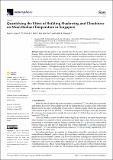| dc.contributor.author | Acero, Juan A. | |
| dc.contributor.author | Koh, Elliot J. Y. | |
| dc.contributor.author | Tan, Yon Sun | |
| dc.contributor.author | Norford, Leslie K. | |
| dc.date.accessioned | 2021-10-28T12:52:18Z | |
| dc.date.available | 2021-10-28T12:52:18Z | |
| dc.date.issued | 2021-08-06 | |
| dc.identifier.uri | https://hdl.handle.net/1721.1/136687 | |
| dc.description.abstract | Improving the quality of life in urban areas has become a major concern in the last few decades. With a constantly increasing urban population and in a climate change context, detailed knowledge of the impact of urban elements on the outdoor thermal environment is relevant. In this work, we present the results of several climatic campaigns carried out in Singapore aiming to evaluate local urban climate variables. Sensors were deployed simultaneously in different sites. The effect of building shadowing in the diurnal cycle of mean radiant temperature (T<sub>mrt</sub>) is evaluated in different seasons. Although during the Inter-Monsoon season, mean T<sub>mrt</sub> reduction due to building shadow is ≈19 °C, during clear skies days, it can be reduced by ≈30 °C. The T<sub>mrt</sub> difference between sites is analyzed based on the weather conditions, the sky view factor (SVF), and the type of surrounding urban elements. Under building shadow conditions, higher SVF showed higher T<sub>mrt</sub> values, although no correlation was found between T<sub>mrt</sub> and diffuse solar radiation (measured above the urban canopy). The results suggest a relevant contribution of other radiation components (e.g., longwave radiation). The quantitative analysis of the T<sub>mrt</sub> provided in this work is relevant for outdoor thermal comfort strategies in tropical areas such as Singapore. | en_US |
| dc.publisher | Multidisciplinary Digital Publishing Institute | en_US |
| dc.relation.isversionof | http://dx.doi.org/10.3390/atmos12081012 | en_US |
| dc.rights | Creative Commons Attribution | en_US |
| dc.rights.uri | https://creativecommons.org/licenses/by/4.0/ | en_US |
| dc.source | Multidisciplinary Digital Publishing Institute | en_US |
| dc.title | Quantifying the Effect of Building Shadowing and Cloudiness on Mean Radiant Temperature in Singapore | en_US |
| dc.type | Article | en_US |
| dc.identifier.citation | Atmosphere 12 (8): 1012 (2021) | en_US |
| dc.contributor.department | Singapore-MIT Alliance in Research and Technology (SMART) | |
| dc.contributor.department | Massachusetts Institute of Technology. Department of Architecture | |
| dc.identifier.mitlicense | PUBLISHER_CC | |
| dc.eprint.version | Final published version | en_US |
| dc.type.uri | http://purl.org/eprint/type/JournalArticle | en_US |
| eprint.status | http://purl.org/eprint/status/PeerReviewed | en_US |
| dc.date.updated | 2021-08-06T15:19:51Z | |
| dspace.date.submission | 2021-08-06T15:19:51Z | |
| mit.license | PUBLISHER_CC | |
| mit.metadata.status | Authority Work and Publication Information Needed | en_US |
